
Jen Ray’s paintings of “sparring Amazonian women who inhabit decaying, semi-surrealist and strangely beautiful wastelands” evoke the late ‘70s avant-post-psychedelic science fiction worlds one would associate with Heavy Metal (the magazine, not the music), but with a decidedly feminist bent—both in subject matter, and, some might argue, in form as well. Angry, jagged, “masculine” lines are filled in with soft, “feminine” washes of color—that is if colors and lines can even be described as “masculine” or “feminine” in the 21st century.
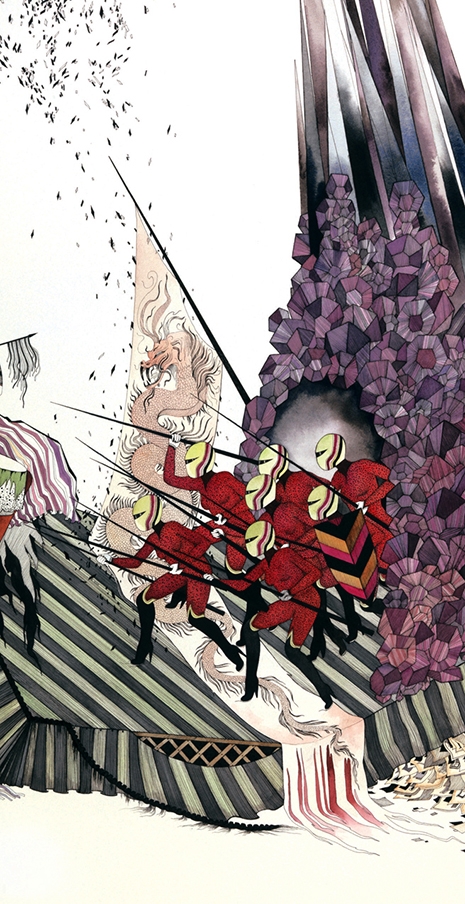
Untitled. 2007. (Detail)—Click on image for larger version.
Ray seems to delight in playing with gender stereotypes, and it’s all the more obvious in the exceptional performance pieces she constructs to augment her magnificent large-scale works of fine art.
North Carolina born, Ray was based out of Berlin for nearly a decade before recently returning to her home state. Her exhibitions of painting and performance have been presented in Berlin, Frankfurt, Munich, Dusseldorf, Wolfsburg, Paris, Copenhagen, Mexico City, Amersfoort (Netherlands), and most recently, at New York’s Albertz Benda gallery.
Ray’s newest exhibition, Deep Cuts, runs at Albertz Benda until November 7th. The presentation which accompanied the opening, directed by Ray, featured a performance by Honeychild Coleman and Amor Schumacher along with a chorus of women backing up détourned renditions of Public Enemy’s “Countdown to Armageddon” and The Guess Who’s “American Woman.”
In a world where the mere mention of the phrase “performance art” sends eyes rolling with assumptions of self-indulgent, pretentious, mess-making (and add the word “feminist” to that phrase and you’ll likely lose even more dudebro interest) it’s remarkable how entertaining, as well as conceptual and thought-provoking, Jen Ray’s productions are. It’s very nearly as populist as it is powerful in its approach.
Give it a couple of minutes to ramp up and stick with it till the end… this is killer:
The first of Jen Ray’s performance works that I viewed (and still my favorite) was Hits which takes Black Flag’s tongue-in-cheek 1987 macho party-anthem “Annihilate This Week” and turns it on its ass. My remark upon first viewing this piece was “this is more interesting than any (punk band’s) show I’ve been to in the past five years.” The sterile atmosphere of the gallery space and its attendees being invaded by singer “Mad Kate” out-Rollins-ing Rollins somehow makes the proceedings even more “punk.”
This may not be safe for some work environments:
A similar performance for Jen Ray’s Better To Reign In Hell Than Serve In Heaven show can be found HERE.
Jen Ray’s Last Call show featured a performance of Black Sabbath’s “Sweet Leaf” sung by Viennese performer Ihu Anyanwu. Ray has described her own work as having been “inspired by cultural personalities such as Kenneth Anger, Grace Jones and Black Sabbath,” and that is most apparent here:
Jen Ray was kind enough to indulge a round of questions about the inspiration and aesthetic behind her provocative work:
Dangerous Minds: As a female artist who primarily paints women and features women in performance pieces, do you consider yourself a “feminist” artist?
Jen Ray: I’m an artist who is also a feminist artist. Basically, I want to have it all. I’ve studied theory but I have to admit that sometimes I think I’m more influenced by the TV show The Secrets of Isis.
Because I’m a child of the ‘70s, there were a lot of great role models from that time. I was in love with Dolly Parton and I worshipped the story of Harriet Tubman. Later I discovered the artists Carolee Schneeman and Valie Export. The feminist performers of the ‘70s still make you go “whaaaa???” It’s all so completely in your face and over the top. No guts, no glory.

Untitled. 2007. (Detail)—Click on image for larger version.
DM: Has performance always been an aspect of your work or did that come later as a method of augmenting the display of your paintings?
JR: It came later when I realized that I wanted the women to step out of the paintings and to “come to life.” The drawings have always had a soundtrack, it’s just that now it’s filling the room and the women are more aggressive in person than you may have realized. I also had the urge to direct and produce the performances with other women. To get together in a group and to create a lot of energy, that’s very exciting to me.
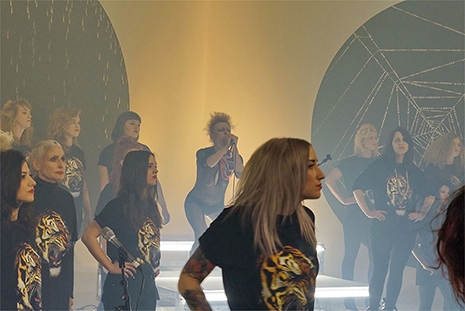
“Hits” performance. 2014.
DM: You have used pop music in your performances, having women perform Black Sabbath’s “Sweet Leaf,” Black Flag’s “Annihilate This Week,” The Guess Who’s “American Woman” and a martial rendition of Question Mark and the Mysterians “96 Tears.” There’s also a nod to Public Enemy in the Deep Cuts piece. Can you elaborate on why these particular songs were chosen and how the meanings of the songs are changed by utilizing a woman’s voice?
JR: All of the songs say something to me. “Sweet Leaf” is a love song to a drug, as opposed to a love song to a man. “Annihilate” is about the shaming of a woman who dared to party too hard. “American Woman” imagines the USA as the Whore of Babylon. I used to think, “why blame a woman for America being so messed up?” But the lyrics have always stuck with me: “colored lights that hypnotize, sparkle someone else’s eyes.”
When I came back to America from Berlin, I really wanted to work with some Public Enemy lyrics because to me it’s a great match-up to American Woman. PE is the ultimate American “band.”
I think carefully about the type of woman I would like to interpret the song. I’m lucky to know a lot of women who are professional performers who have their own careers. Then we begin the process of working together. By having a woman sing a song typically sung by a male, it flips the whole thing on its head. I like to emphasize certain lyrics, using a woman’s voice to achieve it.
DM: On the subject of “Sweet Leaf,” isn’t it odd that there aren’t a lot of songs about drugs by female singers? Obviously women enjoy mind-altering substances as much as men—but the “drug ode” seems a very masculine thing in our culture. It’s great that you’ve subverted that in the Last Call performance. Why do you think there are still some topics not often celebrated by women in popular song that are firmly rooted in male-dominated hesher-culture?
JR: When men sing about drugs it’s “bad-ass,” with women it can come off as wistful and sad—more of a cautionary tale. However, I do love Grace Slick singing “White Rabbit.” She sounds so cool and tough.
DM: Ha! How in the world did I forget about “White Rabbit?” Do you have a philosophy behind the use of pop music in general for these performances? Is it a kind of “sampling” of modern culture?
JR: I listen to the song many times over and think a great deal about the lyrics. I cut and paste the lyrics together and also work with a musician to change the sound of the song and add new bits and pieces to it, so it’s absolutely a form of pop sampling. When I’m making a sculpture I’m manipulating the raw materials, and in the performances words and music are treated the same.
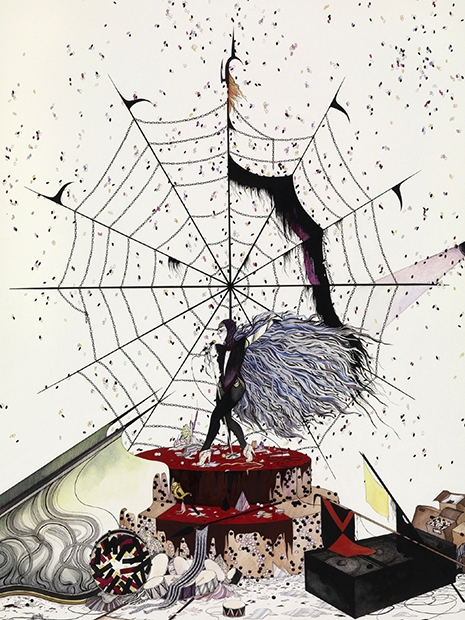
Untitled. 2007. (Detail)—Click on image for larger version.
DM: One of the things I like best about the performances I’ve seen is that they walk a line between conceptual art and entertainment. 50 years or more after the Vienna Aktionists shocked the world with their bloody performances, a lot of performance art today is considered overtly pretentious and held up to ridicule. Every few months some new story goes Internet-viral about an artist popping paint eggs out of her vagina or peeing into a can of Spaghetti-O’s to much virtual eye-rolling. Is it important at all for you to entertain your audience?
JR: Oh those nasty Aktionists! Going back to the pop aspect, I’ve always gotten a much bigger kick from the many music shows I’ve attended since the age of fifteen. Even though I studied performance art, I keep going back to the passion of those early music shows. I feel that the women in the performances are creating the performance for themselves, not the audience. Although, of course they also entertain. I’m using entertainment as a performance element not as the purpose of the performance.
DM: But do you think the pieces are more effective because they ARE entertaining and have a “rock show” like quality?
JR: Yes, definitely, I have to admit that I’ve sat through a lot of dull performances with low production values that didn’t say anything new. I wanted something different. I don’t think abstract conceptualism is a dead horse but you have to be very clever to make a performative statement about it. So often I’ve thought, you’re going to have to do better than that!

Untitled. 2008. (Detail)—Click on image for larger version.
DM: Is there an intentional recurring theme to your performances with the very ritualistic entrance of a female chorus to support a lead voice?
JR: I love a good Greek chorus. It also has something to do with perverting the idea of well behaved backup singers. And yes, I do love the ritualistic aspect of it all—an army supporting its leader!
DM: Is there a selection process involved for the “look” of your performers? How much of this is under your control and how much do they bring to the table? Maybe I’m asking “are you a control freak?” when it comes to the spectacle you put on.
JR: I’m not a control freak, I explain very carefully what kind of look I’m after and usually after the first explanation people get it. We all feel really good afterwards, high-fiveing and fist pumping. The only time it didn’t happen was when I went into labor immediately after the performance of Barbelo. True Story! All the performers said “wasn’t that great?!” and I said, “yee-oww!”
DM: We talked so much about performance, but not specifically about your paintings which inspire those performances. Do you follow any sort of mission or aesthetic when it comes to your work?
JR: As mentioned, I began the performances as a way to bring the drawings to life. In the drawings, the women are struggling and fighting and enjoying themselves and they are enjoying a kind of anarchy. Some of the themes of the drawings are dystopia, cycles of destruction, glamour, sexuality, rebelliousness, humor, irony and grandeur. In each individual work there are themes within themes. I think the same could be said of the performances.
More of Jen Ray’s incredible work can be found at her website.
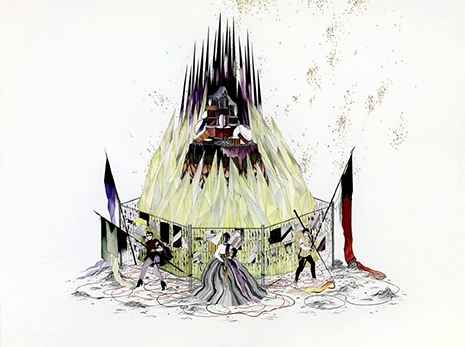
Untitled. 2007.—Click on image for larger version.
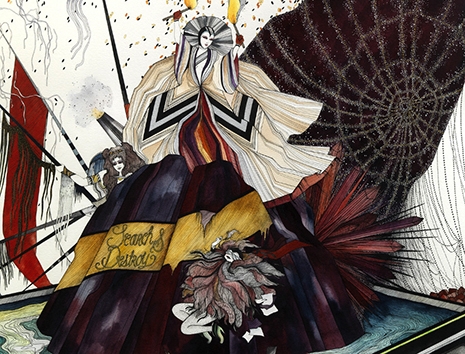
Untitled. 2008. (Detail)—Click on image for larger version.

Untitled. 2008. (Detail)—Click on image for larger version.

Untitled. 2008. (Detail)—Click on image for larger version.

Untitled. 2008. (Detail)—Click on image for larger version.
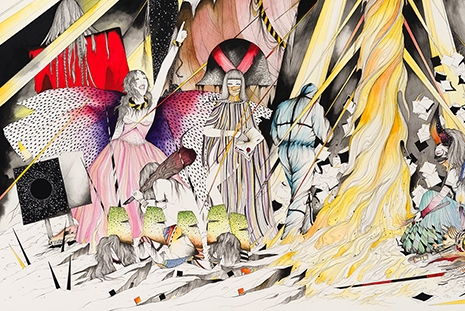
Untitled. 2013. (Detail)—Click on image for larger version.
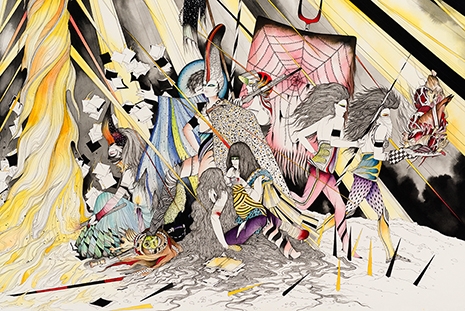
Untitled. 2013. (Detail)—Click on image for larger version.
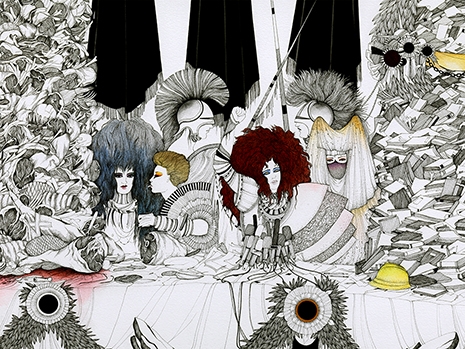
Untitled. 2011. (Detail)—Click on image for larger version.
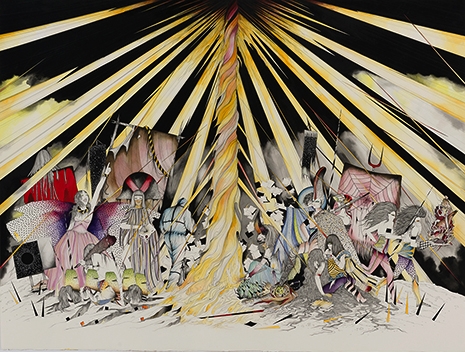
Untitled. 2013. (Detail)
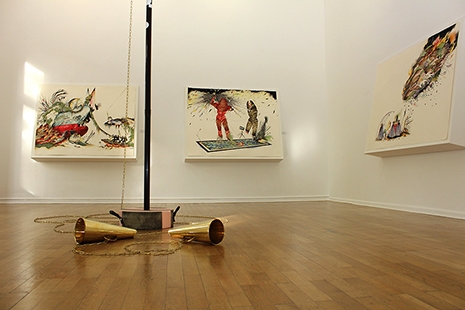
“Better to Reign in Hell Than Serve in Heaven” show. 2013.
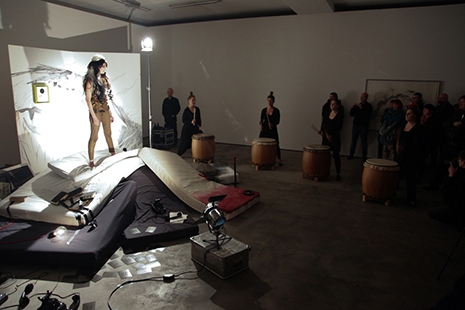
“The Year Zero” show. 2012.

“Deep Cuts” show. 2015.